Evaluating HR Value and Contribution to Organizational Success Report
VerifiedAdded on 2023/01/05
|12
|3919
|57
Report
AI Summary
This report examines the value and contribution of Human Resources to organizational success, focusing on organizational design, employee motivation, and change management, using Syngenta as a case study. The report begins with an evaluation of the significance of organizational design, exploring its impact on efficiency, employee performance, and product quality. It then analyzes the importance of developing motivated, knowledgeable, and experienced individuals and teams, discussing approaches like training and development and motivational theories. The report also assesses how organizational design must respond to and adapt to change management, highlighting the relationship between the two. The report covers different theories like transformation theory, change theory, McClelland theory of motivation and Herzberg two factor theory. The report concludes by emphasizing the critical role of HR in driving organizational success through strategic design and effective change management.
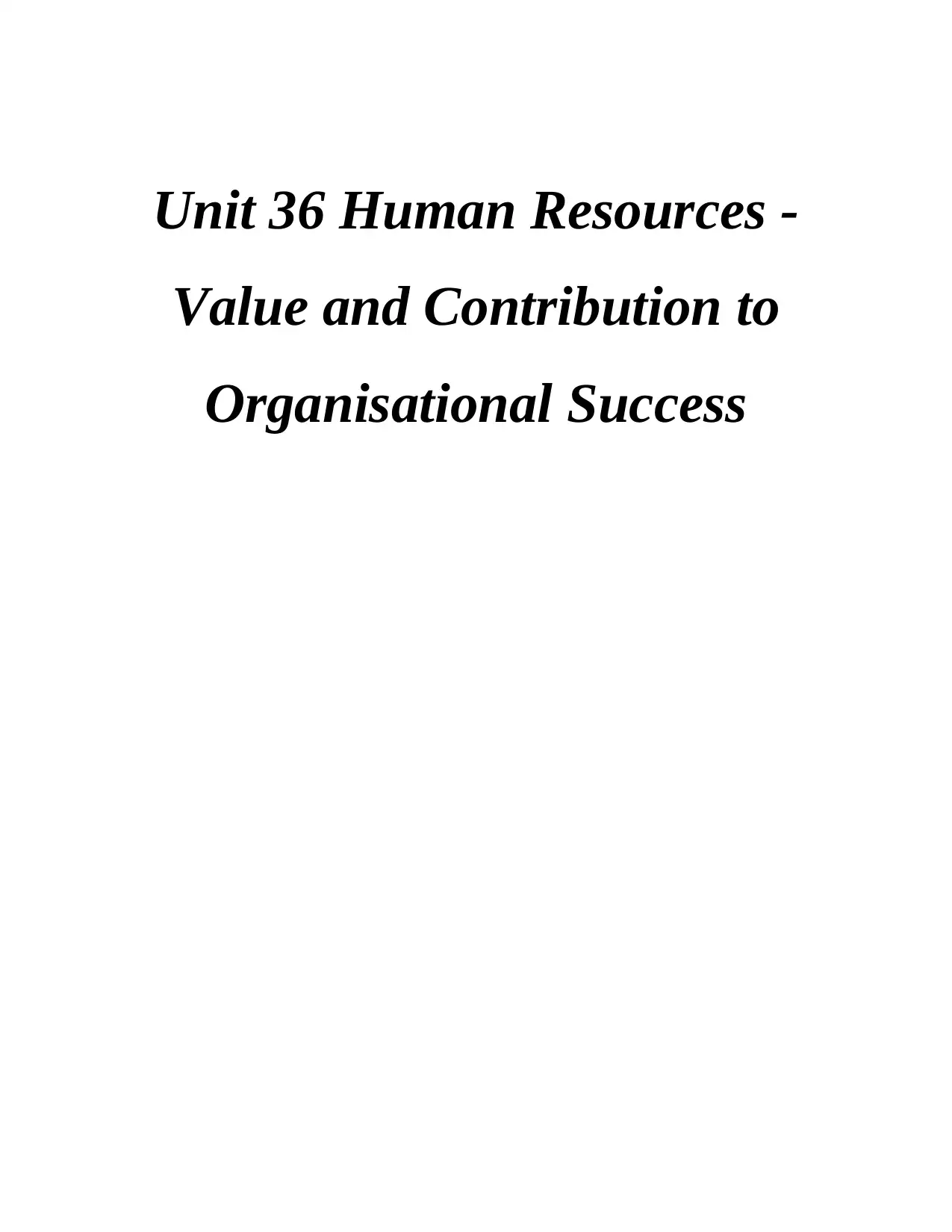
Unit 36 Human Resources -
Value and Contribution to
Organisational Success
Value and Contribution to
Organisational Success
Paraphrase This Document
Need a fresh take? Get an instant paraphrase of this document with our AI Paraphraser
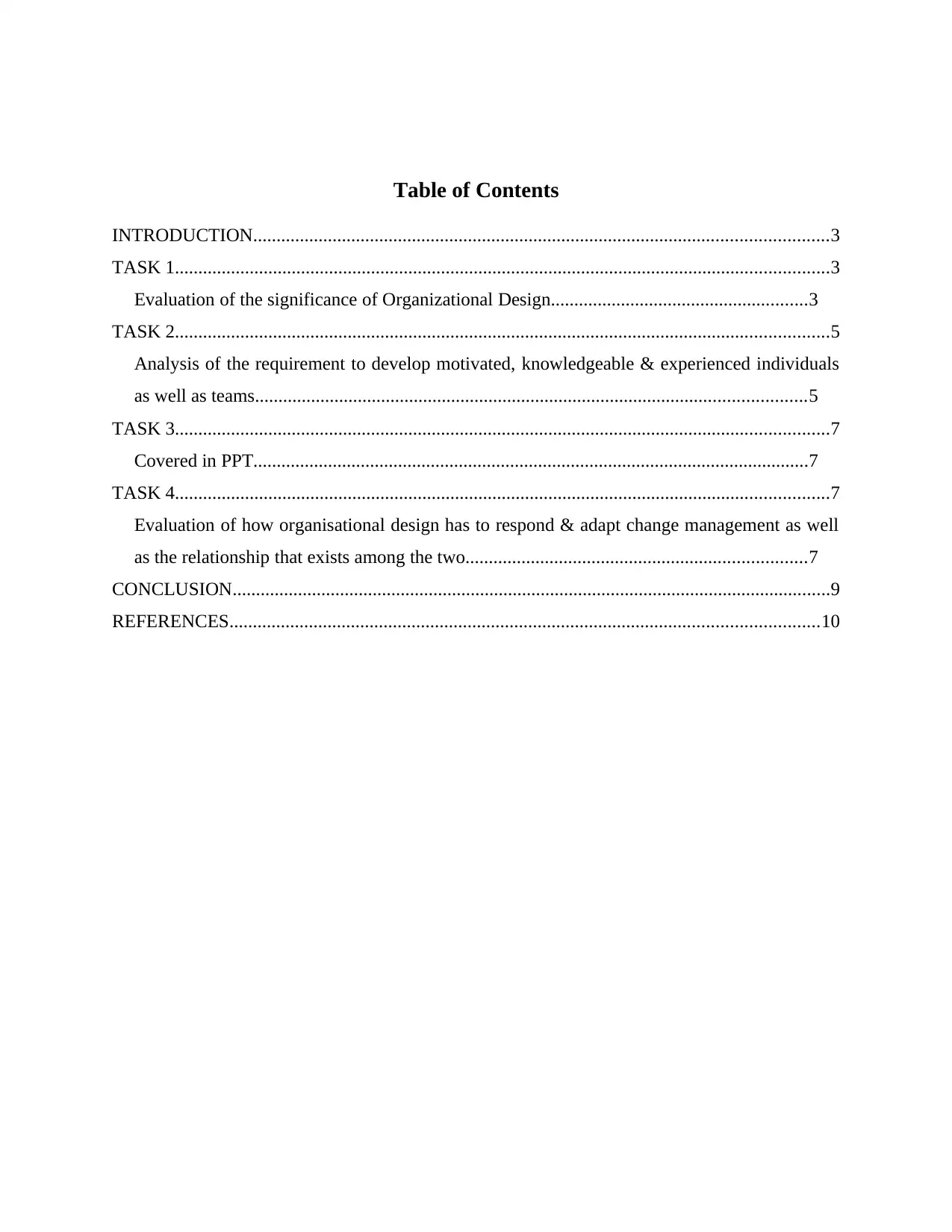
Table of Contents
INTRODUCTION...........................................................................................................................3
TASK 1............................................................................................................................................3
Evaluation of the significance of Organizational Design.......................................................3
TASK 2............................................................................................................................................5
Analysis of the requirement to develop motivated, knowledgeable & experienced individuals
as well as teams......................................................................................................................5
TASK 3............................................................................................................................................7
Covered in PPT.......................................................................................................................7
TASK 4............................................................................................................................................7
Evaluation of how organisational design has to respond & adapt change management as well
as the relationship that exists among the two.........................................................................7
CONCLUSION................................................................................................................................9
REFERENCES..............................................................................................................................10
INTRODUCTION...........................................................................................................................3
TASK 1............................................................................................................................................3
Evaluation of the significance of Organizational Design.......................................................3
TASK 2............................................................................................................................................5
Analysis of the requirement to develop motivated, knowledgeable & experienced individuals
as well as teams......................................................................................................................5
TASK 3............................................................................................................................................7
Covered in PPT.......................................................................................................................7
TASK 4............................................................................................................................................7
Evaluation of how organisational design has to respond & adapt change management as well
as the relationship that exists among the two.........................................................................7
CONCLUSION................................................................................................................................9
REFERENCES..............................................................................................................................10
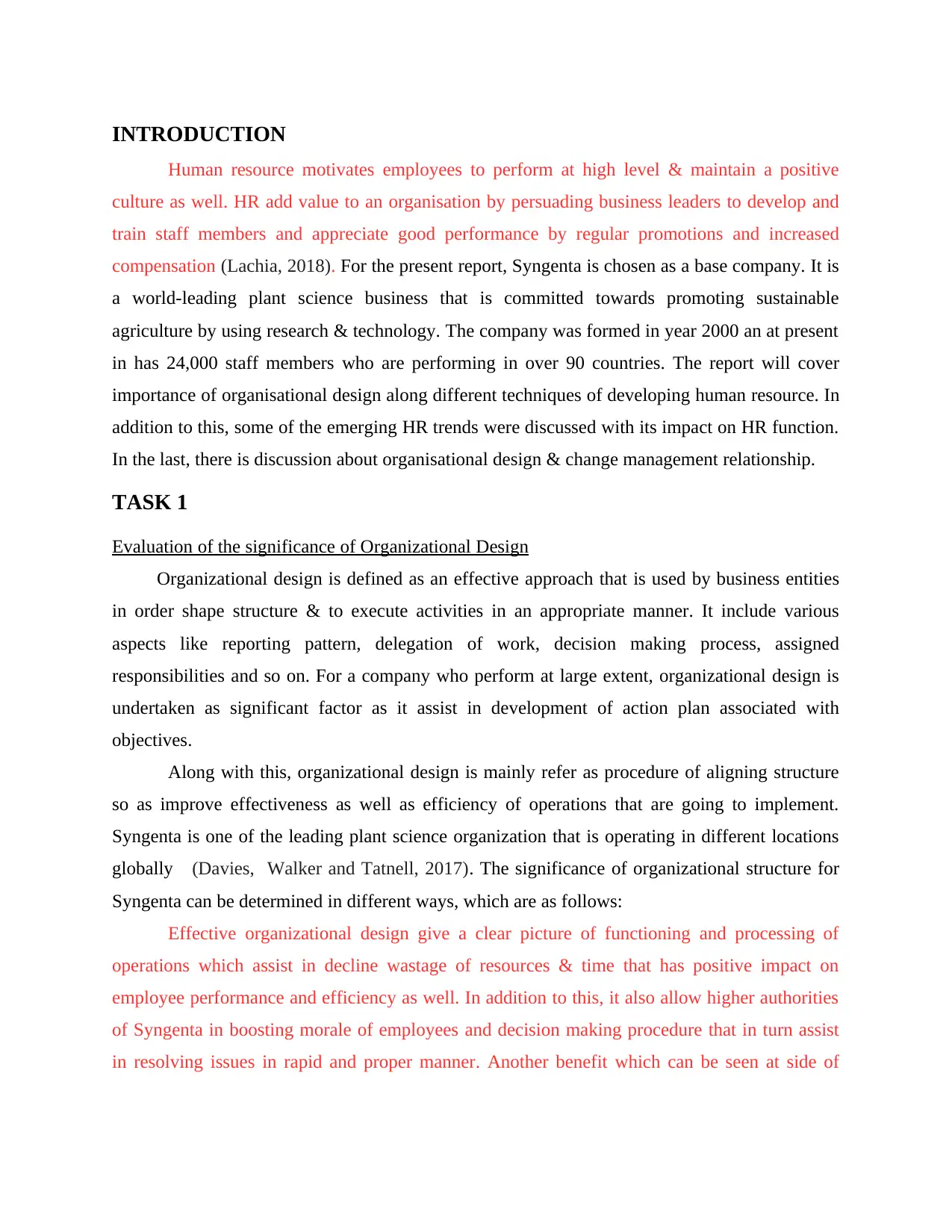
INTRODUCTION
Human resource motivates employees to perform at high level & maintain a positive
culture as well. HR add value to an organisation by persuading business leaders to develop and
train staff members and appreciate good performance by regular promotions and increased
compensation (Lachia, 2018). For the present report, Syngenta is chosen as a base company. It is
a world-leading plant science business that is committed towards promoting sustainable
agriculture by using research & technology. The company was formed in year 2000 an at present
in has 24,000 staff members who are performing in over 90 countries. The report will cover
importance of organisational design along different techniques of developing human resource. In
addition to this, some of the emerging HR trends were discussed with its impact on HR function.
In the last, there is discussion about organisational design & change management relationship.
TASK 1
Evaluation of the significance of Organizational Design
Organizational design is defined as an effective approach that is used by business entities
in order shape structure & to execute activities in an appropriate manner. It include various
aspects like reporting pattern, delegation of work, decision making process, assigned
responsibilities and so on. For a company who perform at large extent, organizational design is
undertaken as significant factor as it assist in development of action plan associated with
objectives.
Along with this, organizational design is mainly refer as procedure of aligning structure
so as improve effectiveness as well as efficiency of operations that are going to implement.
Syngenta is one of the leading plant science organization that is operating in different locations
globally (Davies, Walker and Tatnell, 2017). The significance of organizational structure for
Syngenta can be determined in different ways, which are as follows:
Effective organizational design give a clear picture of functioning and processing of
operations which assist in decline wastage of resources & time that has positive impact on
employee performance and efficiency as well. In addition to this, it also allow higher authorities
of Syngenta in boosting morale of employees and decision making procedure that in turn assist
in resolving issues in rapid and proper manner. Another benefit which can be seen at side of
Human resource motivates employees to perform at high level & maintain a positive
culture as well. HR add value to an organisation by persuading business leaders to develop and
train staff members and appreciate good performance by regular promotions and increased
compensation (Lachia, 2018). For the present report, Syngenta is chosen as a base company. It is
a world-leading plant science business that is committed towards promoting sustainable
agriculture by using research & technology. The company was formed in year 2000 an at present
in has 24,000 staff members who are performing in over 90 countries. The report will cover
importance of organisational design along different techniques of developing human resource. In
addition to this, some of the emerging HR trends were discussed with its impact on HR function.
In the last, there is discussion about organisational design & change management relationship.
TASK 1
Evaluation of the significance of Organizational Design
Organizational design is defined as an effective approach that is used by business entities
in order shape structure & to execute activities in an appropriate manner. It include various
aspects like reporting pattern, delegation of work, decision making process, assigned
responsibilities and so on. For a company who perform at large extent, organizational design is
undertaken as significant factor as it assist in development of action plan associated with
objectives.
Along with this, organizational design is mainly refer as procedure of aligning structure
so as improve effectiveness as well as efficiency of operations that are going to implement.
Syngenta is one of the leading plant science organization that is operating in different locations
globally (Davies, Walker and Tatnell, 2017). The significance of organizational structure for
Syngenta can be determined in different ways, which are as follows:
Effective organizational design give a clear picture of functioning and processing of
operations which assist in decline wastage of resources & time that has positive impact on
employee performance and efficiency as well. In addition to this, it also allow higher authorities
of Syngenta in boosting morale of employees and decision making procedure that in turn assist
in resolving issues in rapid and proper manner. Another benefit which can be seen at side of
⊘ This is a preview!⊘
Do you want full access?
Subscribe today to unlock all pages.

Trusted by 1+ million students worldwide
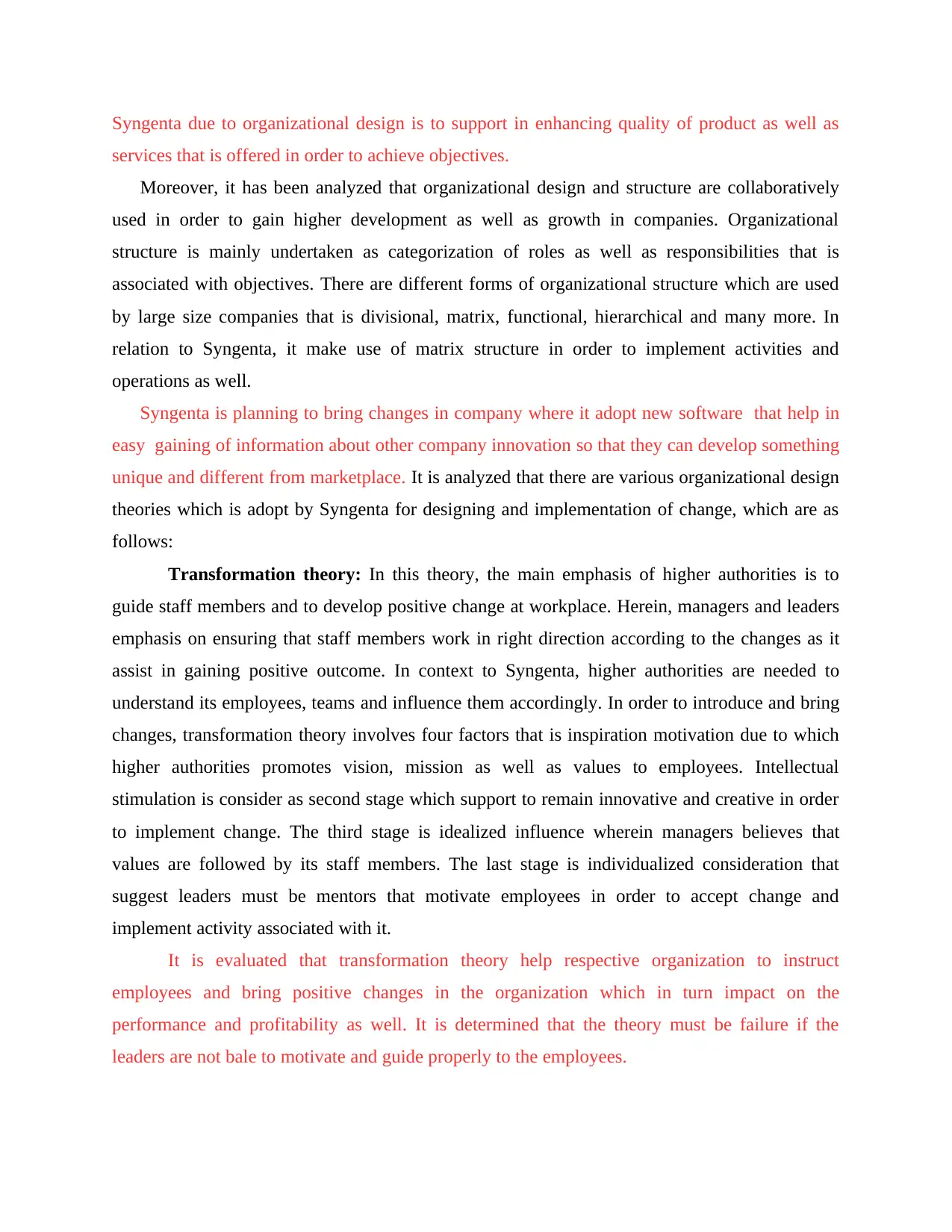
Syngenta due to organizational design is to support in enhancing quality of product as well as
services that is offered in order to achieve objectives.
Moreover, it has been analyzed that organizational design and structure are collaboratively
used in order to gain higher development as well as growth in companies. Organizational
structure is mainly undertaken as categorization of roles as well as responsibilities that is
associated with objectives. There are different forms of organizational structure which are used
by large size companies that is divisional, matrix, functional, hierarchical and many more. In
relation to Syngenta, it make use of matrix structure in order to implement activities and
operations as well.
Syngenta is planning to bring changes in company where it adopt new software that help in
easy gaining of information about other company innovation so that they can develop something
unique and different from marketplace. It is analyzed that there are various organizational design
theories which is adopt by Syngenta for designing and implementation of change, which are as
follows:
Transformation theory: In this theory, the main emphasis of higher authorities is to
guide staff members and to develop positive change at workplace. Herein, managers and leaders
emphasis on ensuring that staff members work in right direction according to the changes as it
assist in gaining positive outcome. In context to Syngenta, higher authorities are needed to
understand its employees, teams and influence them accordingly. In order to introduce and bring
changes, transformation theory involves four factors that is inspiration motivation due to which
higher authorities promotes vision, mission as well as values to employees. Intellectual
stimulation is consider as second stage which support to remain innovative and creative in order
to implement change. The third stage is idealized influence wherein managers believes that
values are followed by its staff members. The last stage is individualized consideration that
suggest leaders must be mentors that motivate employees in order to accept change and
implement activity associated with it.
It is evaluated that transformation theory help respective organization to instruct
employees and bring positive changes in the organization which in turn impact on the
performance and profitability as well. It is determined that the theory must be failure if the
leaders are not bale to motivate and guide properly to the employees.
services that is offered in order to achieve objectives.
Moreover, it has been analyzed that organizational design and structure are collaboratively
used in order to gain higher development as well as growth in companies. Organizational
structure is mainly undertaken as categorization of roles as well as responsibilities that is
associated with objectives. There are different forms of organizational structure which are used
by large size companies that is divisional, matrix, functional, hierarchical and many more. In
relation to Syngenta, it make use of matrix structure in order to implement activities and
operations as well.
Syngenta is planning to bring changes in company where it adopt new software that help in
easy gaining of information about other company innovation so that they can develop something
unique and different from marketplace. It is analyzed that there are various organizational design
theories which is adopt by Syngenta for designing and implementation of change, which are as
follows:
Transformation theory: In this theory, the main emphasis of higher authorities is to
guide staff members and to develop positive change at workplace. Herein, managers and leaders
emphasis on ensuring that staff members work in right direction according to the changes as it
assist in gaining positive outcome. In context to Syngenta, higher authorities are needed to
understand its employees, teams and influence them accordingly. In order to introduce and bring
changes, transformation theory involves four factors that is inspiration motivation due to which
higher authorities promotes vision, mission as well as values to employees. Intellectual
stimulation is consider as second stage which support to remain innovative and creative in order
to implement change. The third stage is idealized influence wherein managers believes that
values are followed by its staff members. The last stage is individualized consideration that
suggest leaders must be mentors that motivate employees in order to accept change and
implement activity associated with it.
It is evaluated that transformation theory help respective organization to instruct
employees and bring positive changes in the organization which in turn impact on the
performance and profitability as well. It is determined that the theory must be failure if the
leaders are not bale to motivate and guide properly to the employees.
Paraphrase This Document
Need a fresh take? Get an instant paraphrase of this document with our AI Paraphraser
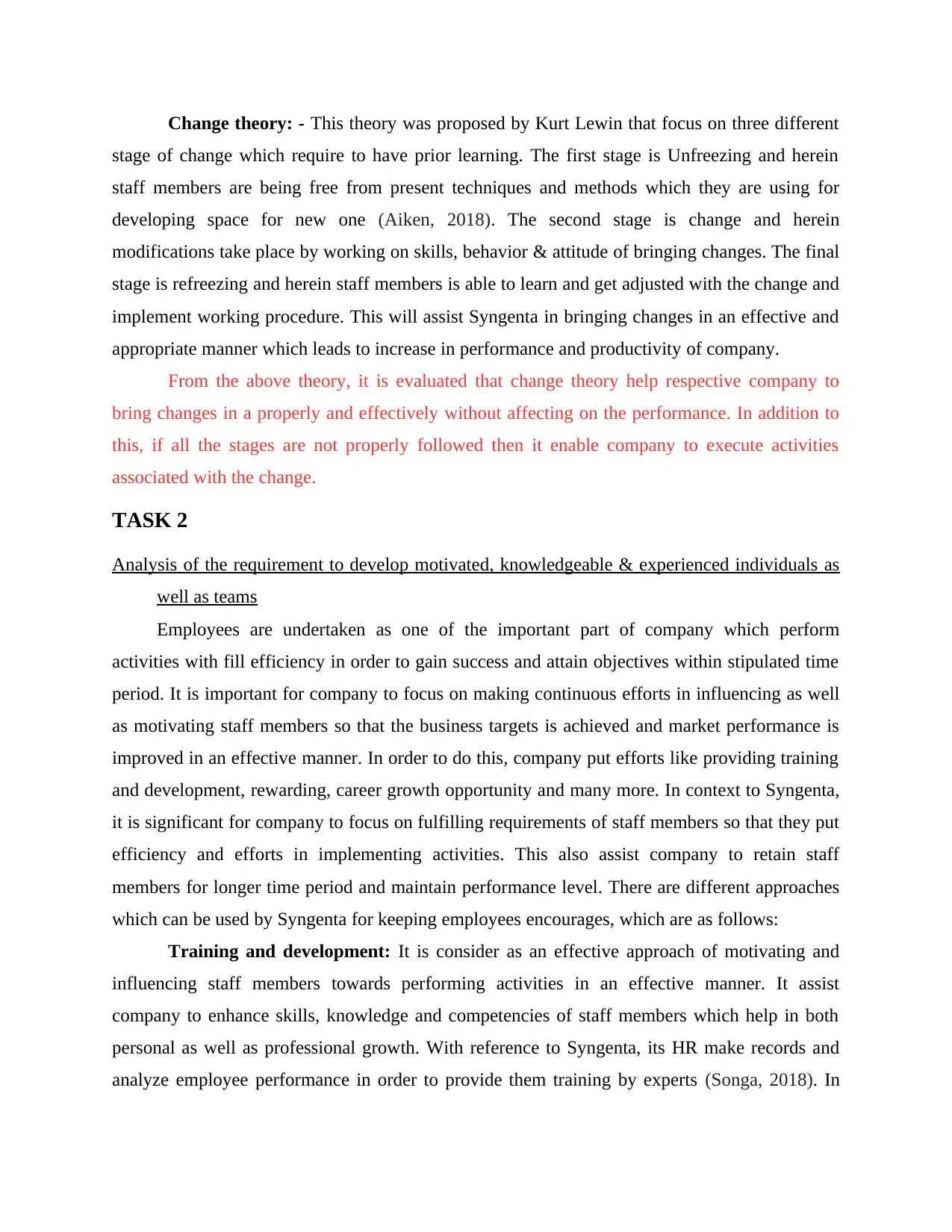
Change theory: - This theory was proposed by Kurt Lewin that focus on three different
stage of change which require to have prior learning. The first stage is Unfreezing and herein
staff members are being free from present techniques and methods which they are using for
developing space for new one (Aiken, 2018). The second stage is change and herein
modifications take place by working on skills, behavior & attitude of bringing changes. The final
stage is refreezing and herein staff members is able to learn and get adjusted with the change and
implement working procedure. This will assist Syngenta in bringing changes in an effective and
appropriate manner which leads to increase in performance and productivity of company.
From the above theory, it is evaluated that change theory help respective company to
bring changes in a properly and effectively without affecting on the performance. In addition to
this, if all the stages are not properly followed then it enable company to execute activities
associated with the change.
TASK 2
Analysis of the requirement to develop motivated, knowledgeable & experienced individuals as
well as teams
Employees are undertaken as one of the important part of company which perform
activities with fill efficiency in order to gain success and attain objectives within stipulated time
period. It is important for company to focus on making continuous efforts in influencing as well
as motivating staff members so that the business targets is achieved and market performance is
improved in an effective manner. In order to do this, company put efforts like providing training
and development, rewarding, career growth opportunity and many more. In context to Syngenta,
it is significant for company to focus on fulfilling requirements of staff members so that they put
efficiency and efforts in implementing activities. This also assist company to retain staff
members for longer time period and maintain performance level. There are different approaches
which can be used by Syngenta for keeping employees encourages, which are as follows:
Training and development: It is consider as an effective approach of motivating and
influencing staff members towards performing activities in an effective manner. It assist
company to enhance skills, knowledge and competencies of staff members which help in both
personal as well as professional growth. With reference to Syngenta, its HR make records and
analyze employee performance in order to provide them training by experts (Songa, 2018). In
stage of change which require to have prior learning. The first stage is Unfreezing and herein
staff members are being free from present techniques and methods which they are using for
developing space for new one (Aiken, 2018). The second stage is change and herein
modifications take place by working on skills, behavior & attitude of bringing changes. The final
stage is refreezing and herein staff members is able to learn and get adjusted with the change and
implement working procedure. This will assist Syngenta in bringing changes in an effective and
appropriate manner which leads to increase in performance and productivity of company.
From the above theory, it is evaluated that change theory help respective company to
bring changes in a properly and effectively without affecting on the performance. In addition to
this, if all the stages are not properly followed then it enable company to execute activities
associated with the change.
TASK 2
Analysis of the requirement to develop motivated, knowledgeable & experienced individuals as
well as teams
Employees are undertaken as one of the important part of company which perform
activities with fill efficiency in order to gain success and attain objectives within stipulated time
period. It is important for company to focus on making continuous efforts in influencing as well
as motivating staff members so that the business targets is achieved and market performance is
improved in an effective manner. In order to do this, company put efforts like providing training
and development, rewarding, career growth opportunity and many more. In context to Syngenta,
it is significant for company to focus on fulfilling requirements of staff members so that they put
efficiency and efforts in implementing activities. This also assist company to retain staff
members for longer time period and maintain performance level. There are different approaches
which can be used by Syngenta for keeping employees encourages, which are as follows:
Training and development: It is consider as an effective approach of motivating and
influencing staff members towards performing activities in an effective manner. It assist
company to enhance skills, knowledge and competencies of staff members which help in both
personal as well as professional growth. With reference to Syngenta, its HR make records and
analyze employee performance in order to provide them training by experts (Songa, 2018). In
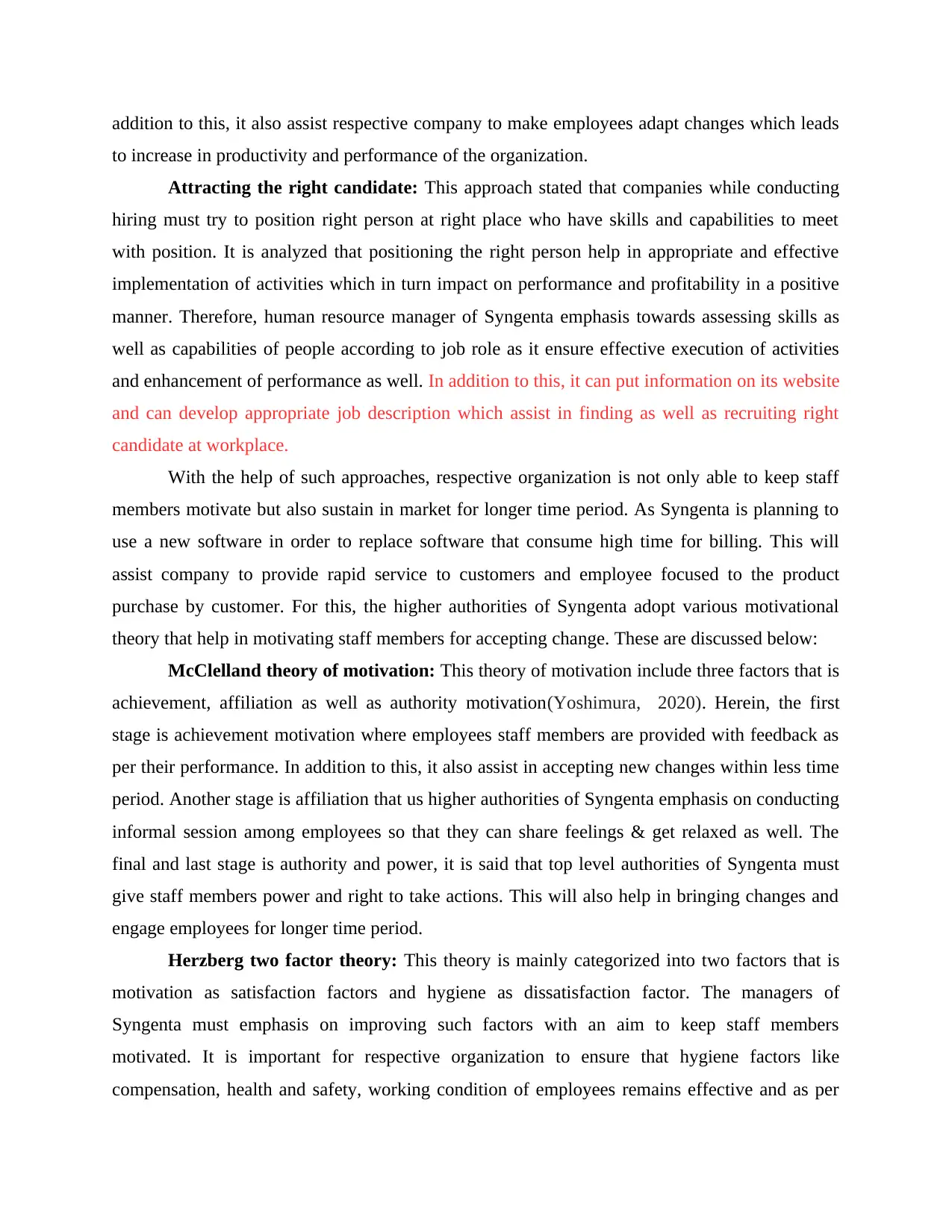
addition to this, it also assist respective company to make employees adapt changes which leads
to increase in productivity and performance of the organization.
Attracting the right candidate: This approach stated that companies while conducting
hiring must try to position right person at right place who have skills and capabilities to meet
with position. It is analyzed that positioning the right person help in appropriate and effective
implementation of activities which in turn impact on performance and profitability in a positive
manner. Therefore, human resource manager of Syngenta emphasis towards assessing skills as
well as capabilities of people according to job role as it ensure effective execution of activities
and enhancement of performance as well. In addition to this, it can put information on its website
and can develop appropriate job description which assist in finding as well as recruiting right
candidate at workplace.
With the help of such approaches, respective organization is not only able to keep staff
members motivate but also sustain in market for longer time period. As Syngenta is planning to
use a new software in order to replace software that consume high time for billing. This will
assist company to provide rapid service to customers and employee focused to the product
purchase by customer. For this, the higher authorities of Syngenta adopt various motivational
theory that help in motivating staff members for accepting change. These are discussed below:
McClelland theory of motivation: This theory of motivation include three factors that is
achievement, affiliation as well as authority motivation(Yoshimura, 2020). Herein, the first
stage is achievement motivation where employees staff members are provided with feedback as
per their performance. In addition to this, it also assist in accepting new changes within less time
period. Another stage is affiliation that us higher authorities of Syngenta emphasis on conducting
informal session among employees so that they can share feelings & get relaxed as well. The
final and last stage is authority and power, it is said that top level authorities of Syngenta must
give staff members power and right to take actions. This will also help in bringing changes and
engage employees for longer time period.
Herzberg two factor theory: This theory is mainly categorized into two factors that is
motivation as satisfaction factors and hygiene as dissatisfaction factor. The managers of
Syngenta must emphasis on improving such factors with an aim to keep staff members
motivated. It is important for respective organization to ensure that hygiene factors like
compensation, health and safety, working condition of employees remains effective and as per
to increase in productivity and performance of the organization.
Attracting the right candidate: This approach stated that companies while conducting
hiring must try to position right person at right place who have skills and capabilities to meet
with position. It is analyzed that positioning the right person help in appropriate and effective
implementation of activities which in turn impact on performance and profitability in a positive
manner. Therefore, human resource manager of Syngenta emphasis towards assessing skills as
well as capabilities of people according to job role as it ensure effective execution of activities
and enhancement of performance as well. In addition to this, it can put information on its website
and can develop appropriate job description which assist in finding as well as recruiting right
candidate at workplace.
With the help of such approaches, respective organization is not only able to keep staff
members motivate but also sustain in market for longer time period. As Syngenta is planning to
use a new software in order to replace software that consume high time for billing. This will
assist company to provide rapid service to customers and employee focused to the product
purchase by customer. For this, the higher authorities of Syngenta adopt various motivational
theory that help in motivating staff members for accepting change. These are discussed below:
McClelland theory of motivation: This theory of motivation include three factors that is
achievement, affiliation as well as authority motivation(Yoshimura, 2020). Herein, the first
stage is achievement motivation where employees staff members are provided with feedback as
per their performance. In addition to this, it also assist in accepting new changes within less time
period. Another stage is affiliation that us higher authorities of Syngenta emphasis on conducting
informal session among employees so that they can share feelings & get relaxed as well. The
final and last stage is authority and power, it is said that top level authorities of Syngenta must
give staff members power and right to take actions. This will also help in bringing changes and
engage employees for longer time period.
Herzberg two factor theory: This theory is mainly categorized into two factors that is
motivation as satisfaction factors and hygiene as dissatisfaction factor. The managers of
Syngenta must emphasis on improving such factors with an aim to keep staff members
motivated. It is important for respective organization to ensure that hygiene factors like
compensation, health and safety, working condition of employees remains effective and as per
⊘ This is a preview!⊘
Do you want full access?
Subscribe today to unlock all pages.

Trusted by 1+ million students worldwide
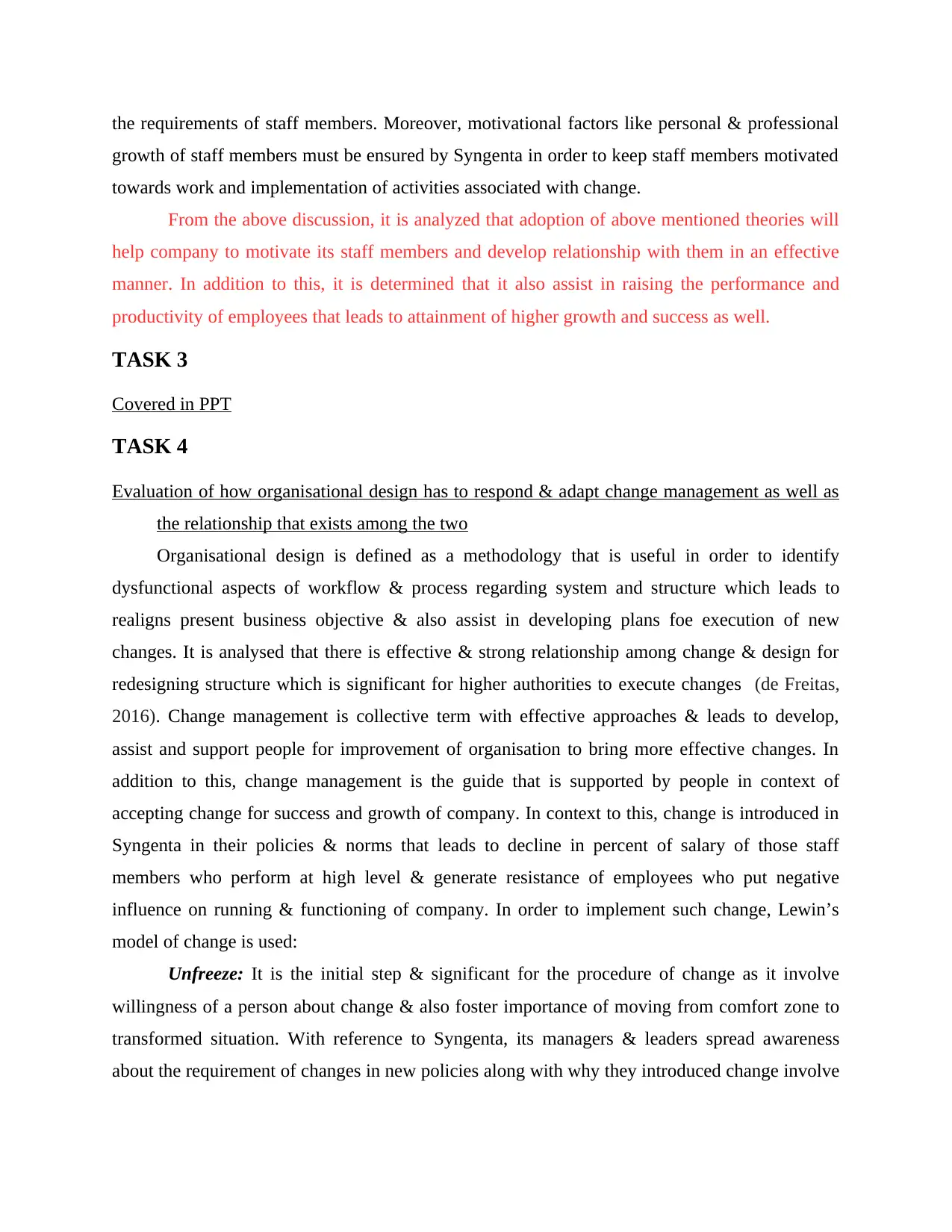
the requirements of staff members. Moreover, motivational factors like personal & professional
growth of staff members must be ensured by Syngenta in order to keep staff members motivated
towards work and implementation of activities associated with change.
From the above discussion, it is analyzed that adoption of above mentioned theories will
help company to motivate its staff members and develop relationship with them in an effective
manner. In addition to this, it is determined that it also assist in raising the performance and
productivity of employees that leads to attainment of higher growth and success as well.
TASK 3
Covered in PPT
TASK 4
Evaluation of how organisational design has to respond & adapt change management as well as
the relationship that exists among the two
Organisational design is defined as a methodology that is useful in order to identify
dysfunctional aspects of workflow & process regarding system and structure which leads to
realigns present business objective & also assist in developing plans foe execution of new
changes. It is analysed that there is effective & strong relationship among change & design for
redesigning structure which is significant for higher authorities to execute changes (de Freitas,
2016). Change management is collective term with effective approaches & leads to develop,
assist and support people for improvement of organisation to bring more effective changes. In
addition to this, change management is the guide that is supported by people in context of
accepting change for success and growth of company. In context to this, change is introduced in
Syngenta in their policies & norms that leads to decline in percent of salary of those staff
members who perform at high level & generate resistance of employees who put negative
influence on running & functioning of company. In order to implement such change, Lewin’s
model of change is used:
Unfreeze: It is the initial step & significant for the procedure of change as it involve
willingness of a person about change & also foster importance of moving from comfort zone to
transformed situation. With reference to Syngenta, its managers & leaders spread awareness
about the requirement of changes in new policies along with why they introduced change involve
growth of staff members must be ensured by Syngenta in order to keep staff members motivated
towards work and implementation of activities associated with change.
From the above discussion, it is analyzed that adoption of above mentioned theories will
help company to motivate its staff members and develop relationship with them in an effective
manner. In addition to this, it is determined that it also assist in raising the performance and
productivity of employees that leads to attainment of higher growth and success as well.
TASK 3
Covered in PPT
TASK 4
Evaluation of how organisational design has to respond & adapt change management as well as
the relationship that exists among the two
Organisational design is defined as a methodology that is useful in order to identify
dysfunctional aspects of workflow & process regarding system and structure which leads to
realigns present business objective & also assist in developing plans foe execution of new
changes. It is analysed that there is effective & strong relationship among change & design for
redesigning structure which is significant for higher authorities to execute changes (de Freitas,
2016). Change management is collective term with effective approaches & leads to develop,
assist and support people for improvement of organisation to bring more effective changes. In
addition to this, change management is the guide that is supported by people in context of
accepting change for success and growth of company. In context to this, change is introduced in
Syngenta in their policies & norms that leads to decline in percent of salary of those staff
members who perform at high level & generate resistance of employees who put negative
influence on running & functioning of company. In order to implement such change, Lewin’s
model of change is used:
Unfreeze: It is the initial step & significant for the procedure of change as it involve
willingness of a person about change & also foster importance of moving from comfort zone to
transformed situation. With reference to Syngenta, its managers & leaders spread awareness
about the requirement of changes in new policies along with why they introduced change involve
Paraphrase This Document
Need a fresh take? Get an instant paraphrase of this document with our AI Paraphraser
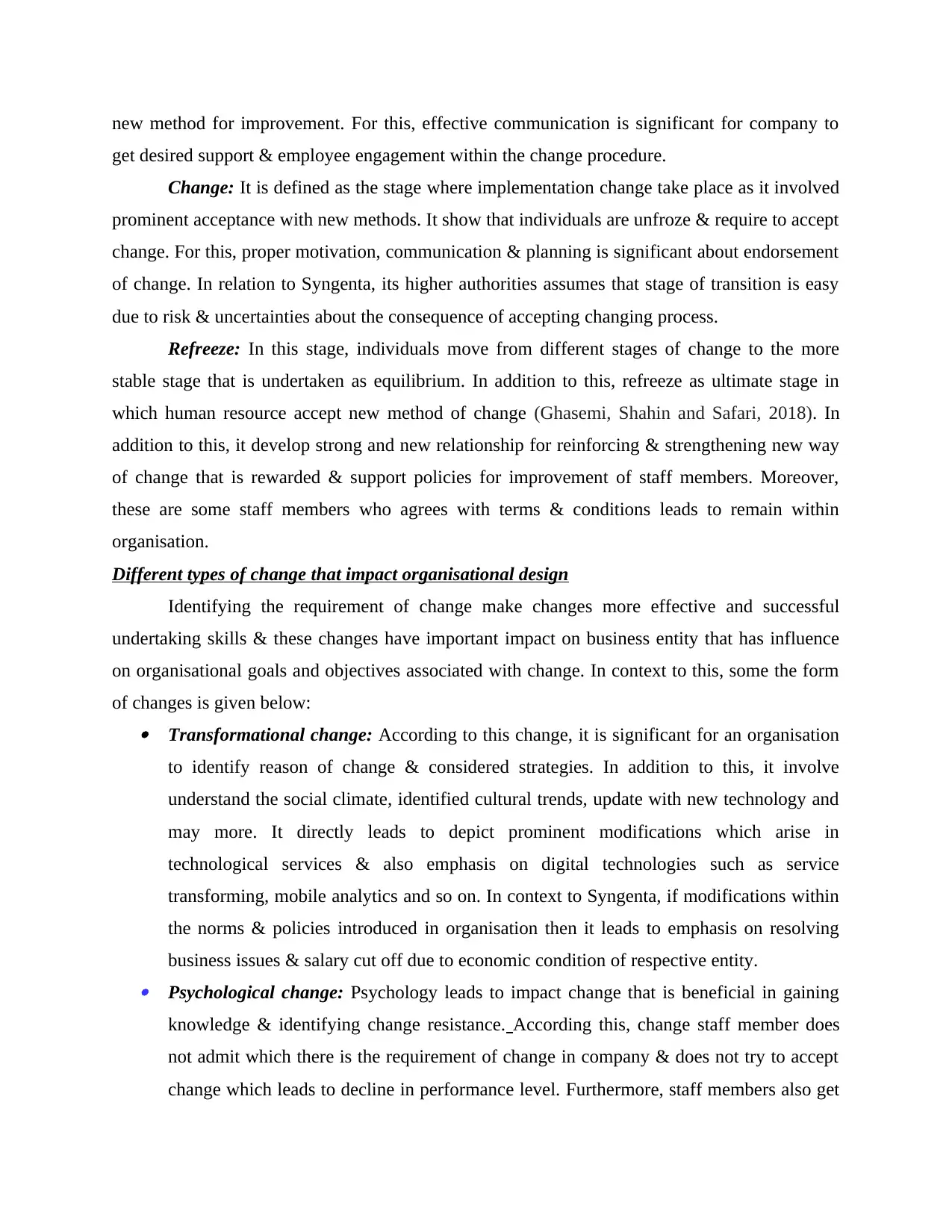
new method for improvement. For this, effective communication is significant for company to
get desired support & employee engagement within the change procedure.
Change: It is defined as the stage where implementation change take place as it involved
prominent acceptance with new methods. It show that individuals are unfroze & require to accept
change. For this, proper motivation, communication & planning is significant about endorsement
of change. In relation to Syngenta, its higher authorities assumes that stage of transition is easy
due to risk & uncertainties about the consequence of accepting changing process.
Refreeze: In this stage, individuals move from different stages of change to the more
stable stage that is undertaken as equilibrium. In addition to this, refreeze as ultimate stage in
which human resource accept new method of change (Ghasemi, Shahin and Safari, 2018). In
addition to this, it develop strong and new relationship for reinforcing & strengthening new way
of change that is rewarded & support policies for improvement of staff members. Moreover,
these are some staff members who agrees with terms & conditions leads to remain within
organisation.
Different types of change that impact organisational design
Identifying the requirement of change make changes more effective and successful
undertaking skills & these changes have important impact on business entity that has influence
on organisational goals and objectives associated with change. In context to this, some the form
of changes is given below: Transformational change: According to this change, it is significant for an organisation
to identify reason of change & considered strategies. In addition to this, it involve
understand the social climate, identified cultural trends, update with new technology and
may more. It directly leads to depict prominent modifications which arise in
technological services & also emphasis on digital technologies such as service
transforming, mobile analytics and so on. In context to Syngenta, if modifications within
the norms & policies introduced in organisation then it leads to emphasis on resolving
business issues & salary cut off due to economic condition of respective entity. Psychological change: Psychology leads to impact change that is beneficial in gaining
knowledge & identifying change resistance. According this, change staff member does
not admit which there is the requirement of change in company & does not try to accept
change which leads to decline in performance level. Furthermore, staff members also get
get desired support & employee engagement within the change procedure.
Change: It is defined as the stage where implementation change take place as it involved
prominent acceptance with new methods. It show that individuals are unfroze & require to accept
change. For this, proper motivation, communication & planning is significant about endorsement
of change. In relation to Syngenta, its higher authorities assumes that stage of transition is easy
due to risk & uncertainties about the consequence of accepting changing process.
Refreeze: In this stage, individuals move from different stages of change to the more
stable stage that is undertaken as equilibrium. In addition to this, refreeze as ultimate stage in
which human resource accept new method of change (Ghasemi, Shahin and Safari, 2018). In
addition to this, it develop strong and new relationship for reinforcing & strengthening new way
of change that is rewarded & support policies for improvement of staff members. Moreover,
these are some staff members who agrees with terms & conditions leads to remain within
organisation.
Different types of change that impact organisational design
Identifying the requirement of change make changes more effective and successful
undertaking skills & these changes have important impact on business entity that has influence
on organisational goals and objectives associated with change. In context to this, some the form
of changes is given below: Transformational change: According to this change, it is significant for an organisation
to identify reason of change & considered strategies. In addition to this, it involve
understand the social climate, identified cultural trends, update with new technology and
may more. It directly leads to depict prominent modifications which arise in
technological services & also emphasis on digital technologies such as service
transforming, mobile analytics and so on. In context to Syngenta, if modifications within
the norms & policies introduced in organisation then it leads to emphasis on resolving
business issues & salary cut off due to economic condition of respective entity. Psychological change: Psychology leads to impact change that is beneficial in gaining
knowledge & identifying change resistance. According this, change staff member does
not admit which there is the requirement of change in company & does not try to accept
change which leads to decline in performance level. Furthermore, staff members also get
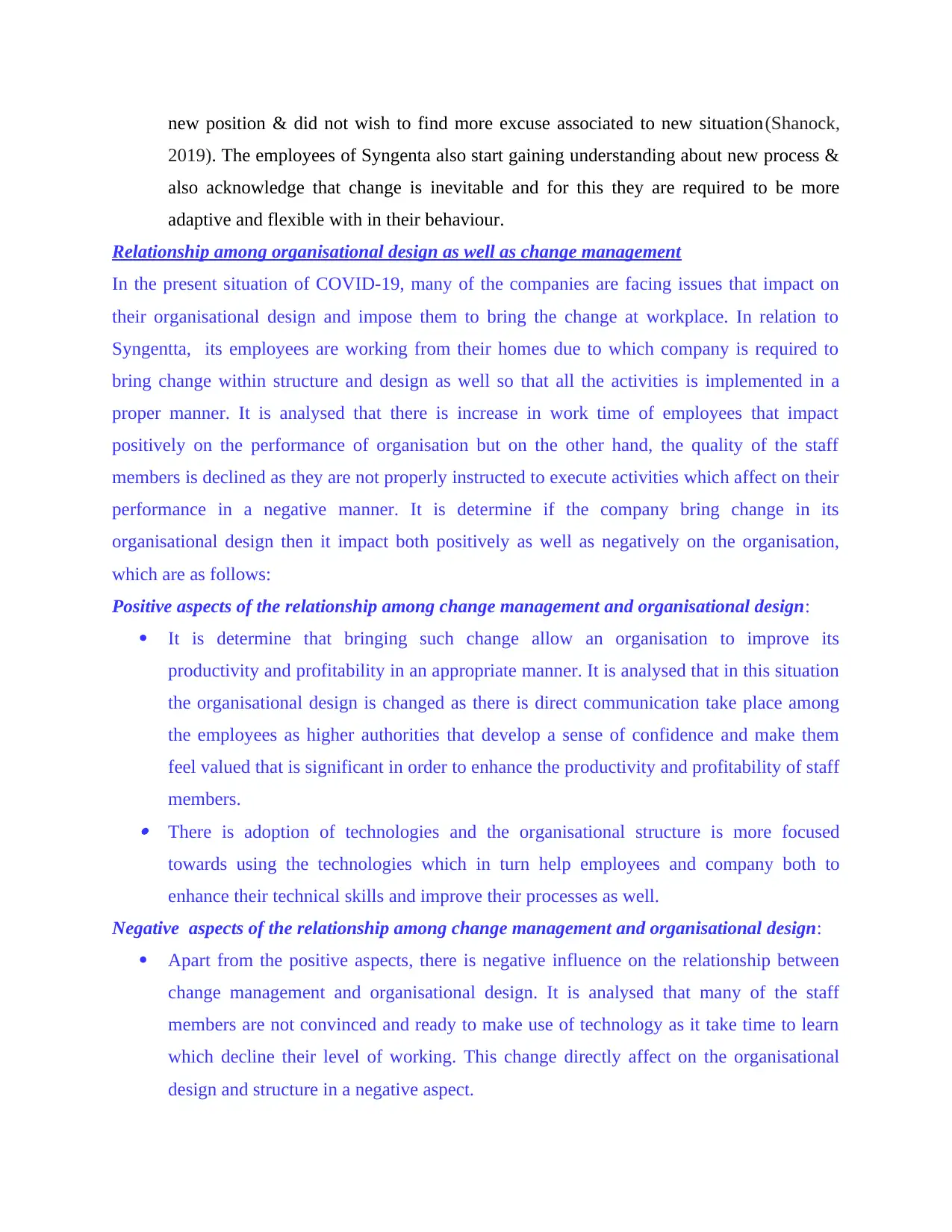
new position & did not wish to find more excuse associated to new situation(Shanock,
2019). The employees of Syngenta also start gaining understanding about new process &
also acknowledge that change is inevitable and for this they are required to be more
adaptive and flexible with in their behaviour.
Relationship among organisational design as well as change management
In the present situation of COVID-19, many of the companies are facing issues that impact on
their organisational design and impose them to bring the change at workplace. In relation to
Syngentta, its employees are working from their homes due to which company is required to
bring change within structure and design as well so that all the activities is implemented in a
proper manner. It is analysed that there is increase in work time of employees that impact
positively on the performance of organisation but on the other hand, the quality of the staff
members is declined as they are not properly instructed to execute activities which affect on their
performance in a negative manner. It is determine if the company bring change in its
organisational design then it impact both positively as well as negatively on the organisation,
which are as follows:
Positive aspects of the relationship among change management and organisational design:
It is determine that bringing such change allow an organisation to improve its
productivity and profitability in an appropriate manner. It is analysed that in this situation
the organisational design is changed as there is direct communication take place among
the employees as higher authorities that develop a sense of confidence and make them
feel valued that is significant in order to enhance the productivity and profitability of staff
members. There is adoption of technologies and the organisational structure is more focused
towards using the technologies which in turn help employees and company both to
enhance their technical skills and improve their processes as well.
Negative aspects of the relationship among change management and organisational design:
Apart from the positive aspects, there is negative influence on the relationship between
change management and organisational design. It is analysed that many of the staff
members are not convinced and ready to make use of technology as it take time to learn
which decline their level of working. This change directly affect on the organisational
design and structure in a negative aspect.
2019). The employees of Syngenta also start gaining understanding about new process &
also acknowledge that change is inevitable and for this they are required to be more
adaptive and flexible with in their behaviour.
Relationship among organisational design as well as change management
In the present situation of COVID-19, many of the companies are facing issues that impact on
their organisational design and impose them to bring the change at workplace. In relation to
Syngentta, its employees are working from their homes due to which company is required to
bring change within structure and design as well so that all the activities is implemented in a
proper manner. It is analysed that there is increase in work time of employees that impact
positively on the performance of organisation but on the other hand, the quality of the staff
members is declined as they are not properly instructed to execute activities which affect on their
performance in a negative manner. It is determine if the company bring change in its
organisational design then it impact both positively as well as negatively on the organisation,
which are as follows:
Positive aspects of the relationship among change management and organisational design:
It is determine that bringing such change allow an organisation to improve its
productivity and profitability in an appropriate manner. It is analysed that in this situation
the organisational design is changed as there is direct communication take place among
the employees as higher authorities that develop a sense of confidence and make them
feel valued that is significant in order to enhance the productivity and profitability of staff
members. There is adoption of technologies and the organisational structure is more focused
towards using the technologies which in turn help employees and company both to
enhance their technical skills and improve their processes as well.
Negative aspects of the relationship among change management and organisational design:
Apart from the positive aspects, there is negative influence on the relationship between
change management and organisational design. It is analysed that many of the staff
members are not convinced and ready to make use of technology as it take time to learn
which decline their level of working. This change directly affect on the organisational
design and structure in a negative aspect.
⊘ This is a preview!⊘
Do you want full access?
Subscribe today to unlock all pages.

Trusted by 1+ million students worldwide
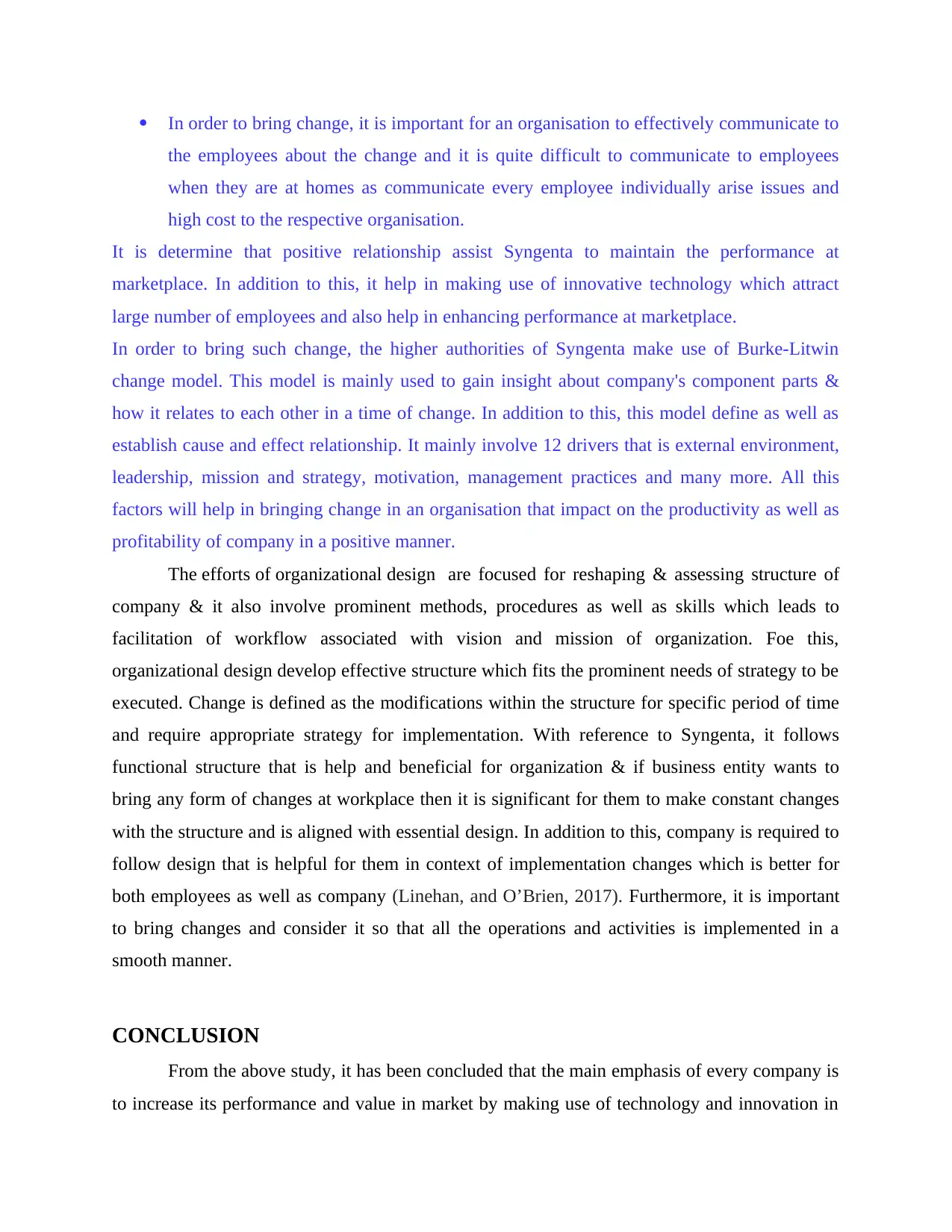
In order to bring change, it is important for an organisation to effectively communicate to
the employees about the change and it is quite difficult to communicate to employees
when they are at homes as communicate every employee individually arise issues and
high cost to the respective organisation.
It is determine that positive relationship assist Syngenta to maintain the performance at
marketplace. In addition to this, it help in making use of innovative technology which attract
large number of employees and also help in enhancing performance at marketplace.
In order to bring such change, the higher authorities of Syngenta make use of Burke-Litwin
change model. This model is mainly used to gain insight about company's component parts &
how it relates to each other in a time of change. In addition to this, this model define as well as
establish cause and effect relationship. It mainly involve 12 drivers that is external environment,
leadership, mission and strategy, motivation, management practices and many more. All this
factors will help in bringing change in an organisation that impact on the productivity as well as
profitability of company in a positive manner.
The efforts of organizational design are focused for reshaping & assessing structure of
company & it also involve prominent methods, procedures as well as skills which leads to
facilitation of workflow associated with vision and mission of organization. Foe this,
organizational design develop effective structure which fits the prominent needs of strategy to be
executed. Change is defined as the modifications within the structure for specific period of time
and require appropriate strategy for implementation. With reference to Syngenta, it follows
functional structure that is help and beneficial for organization & if business entity wants to
bring any form of changes at workplace then it is significant for them to make constant changes
with the structure and is aligned with essential design. In addition to this, company is required to
follow design that is helpful for them in context of implementation changes which is better for
both employees as well as company (Linehan, and O’Brien, 2017). Furthermore, it is important
to bring changes and consider it so that all the operations and activities is implemented in a
smooth manner.
CONCLUSION
From the above study, it has been concluded that the main emphasis of every company is
to increase its performance and value in market by making use of technology and innovation in
the employees about the change and it is quite difficult to communicate to employees
when they are at homes as communicate every employee individually arise issues and
high cost to the respective organisation.
It is determine that positive relationship assist Syngenta to maintain the performance at
marketplace. In addition to this, it help in making use of innovative technology which attract
large number of employees and also help in enhancing performance at marketplace.
In order to bring such change, the higher authorities of Syngenta make use of Burke-Litwin
change model. This model is mainly used to gain insight about company's component parts &
how it relates to each other in a time of change. In addition to this, this model define as well as
establish cause and effect relationship. It mainly involve 12 drivers that is external environment,
leadership, mission and strategy, motivation, management practices and many more. All this
factors will help in bringing change in an organisation that impact on the productivity as well as
profitability of company in a positive manner.
The efforts of organizational design are focused for reshaping & assessing structure of
company & it also involve prominent methods, procedures as well as skills which leads to
facilitation of workflow associated with vision and mission of organization. Foe this,
organizational design develop effective structure which fits the prominent needs of strategy to be
executed. Change is defined as the modifications within the structure for specific period of time
and require appropriate strategy for implementation. With reference to Syngenta, it follows
functional structure that is help and beneficial for organization & if business entity wants to
bring any form of changes at workplace then it is significant for them to make constant changes
with the structure and is aligned with essential design. In addition to this, company is required to
follow design that is helpful for them in context of implementation changes which is better for
both employees as well as company (Linehan, and O’Brien, 2017). Furthermore, it is important
to bring changes and consider it so that all the operations and activities is implemented in a
smooth manner.
CONCLUSION
From the above study, it has been concluded that the main emphasis of every company is
to increase its performance and value in market by making use of technology and innovation in
Paraphrase This Document
Need a fresh take? Get an instant paraphrase of this document with our AI Paraphraser
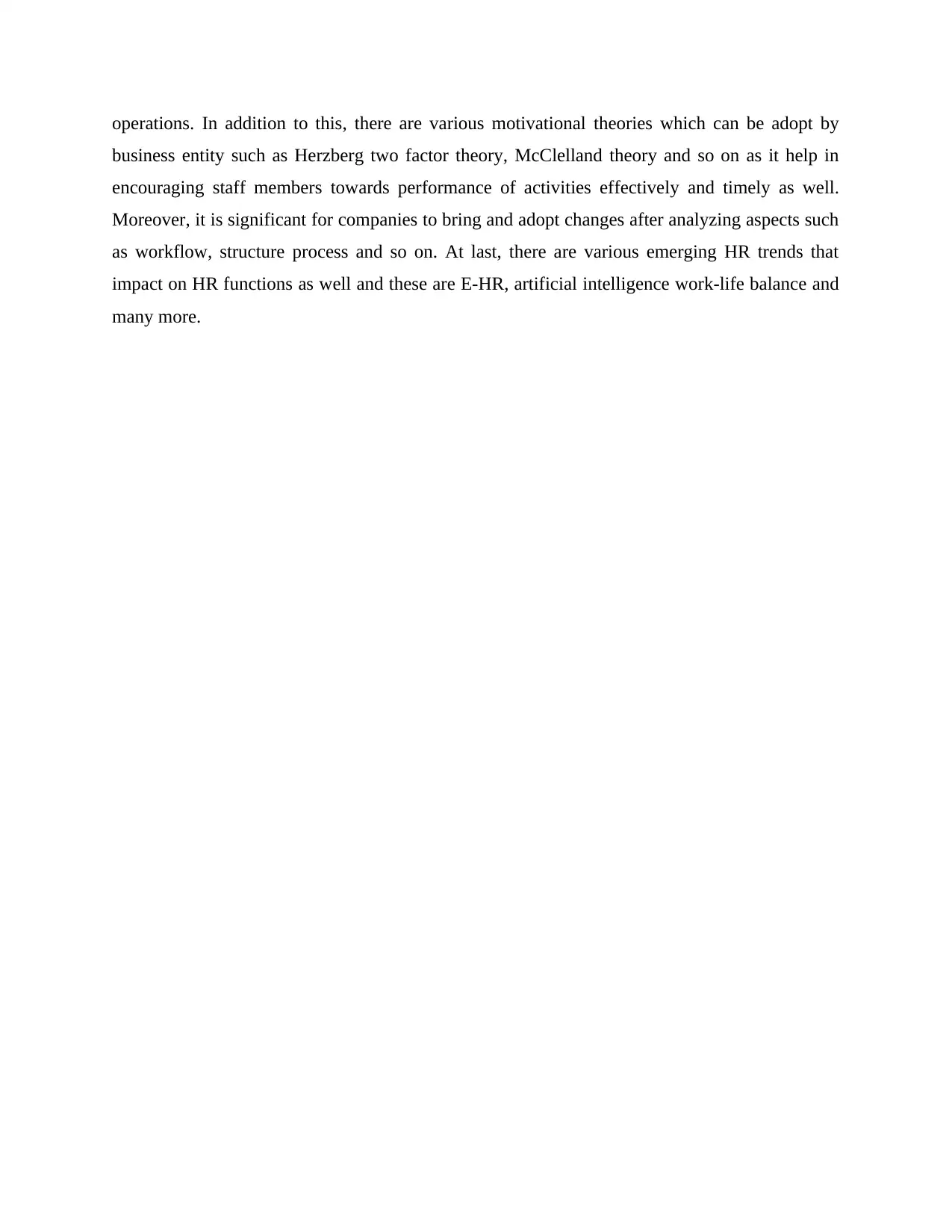
operations. In addition to this, there are various motivational theories which can be adopt by
business entity such as Herzberg two factor theory, McClelland theory and so on as it help in
encouraging staff members towards performance of activities effectively and timely as well.
Moreover, it is significant for companies to bring and adopt changes after analyzing aspects such
as workflow, structure process and so on. At last, there are various emerging HR trends that
impact on HR functions as well and these are E-HR, artificial intelligence work-life balance and
many more.
business entity such as Herzberg two factor theory, McClelland theory and so on as it help in
encouraging staff members towards performance of activities effectively and timely as well.
Moreover, it is significant for companies to bring and adopt changes after analyzing aspects such
as workflow, structure process and so on. At last, there are various emerging HR trends that
impact on HR functions as well and these are E-HR, artificial intelligence work-life balance and
many more.
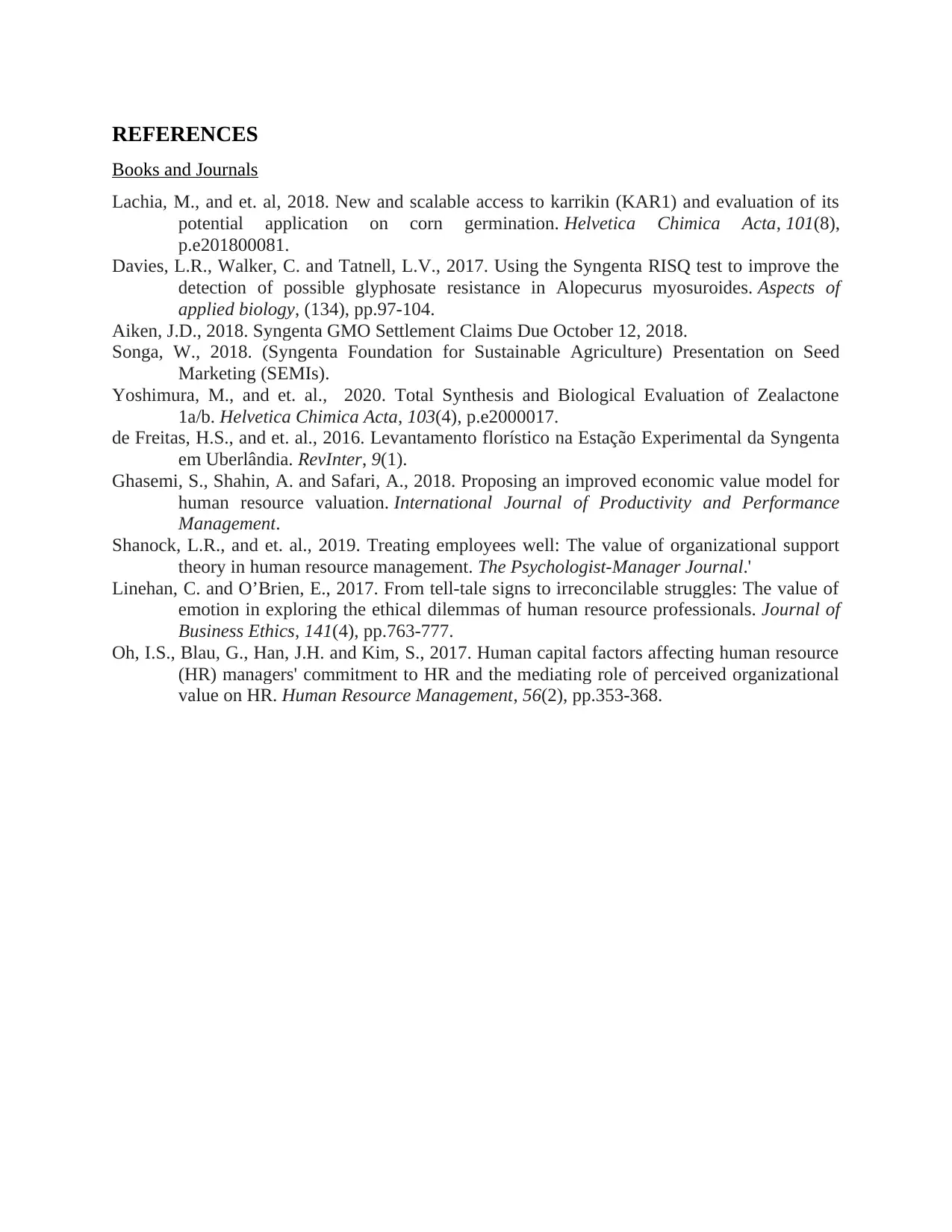
REFERENCES
Books and Journals
Lachia, M., and et. al, 2018. New and scalable access to karrikin (KAR1) and evaluation of its
potential application on corn germination. Helvetica Chimica Acta, 101(8),
p.e201800081.
Davies, L.R., Walker, C. and Tatnell, L.V., 2017. Using the Syngenta RISQ test to improve the
detection of possible glyphosate resistance in Alopecurus myosuroides. Aspects of
applied biology, (134), pp.97-104.
Aiken, J.D., 2018. Syngenta GMO Settlement Claims Due October 12, 2018.
Songa, W., 2018. (Syngenta Foundation for Sustainable Agriculture) Presentation on Seed
Marketing (SEMIs).
Yoshimura, M., and et. al., 2020. Total Synthesis and Biological Evaluation of Zealactone
1a/b. Helvetica Chimica Acta, 103(4), p.e2000017.
de Freitas, H.S., and et. al., 2016. Levantamento florístico na Estação Experimental da Syngenta
em Uberlândia. RevInter, 9(1).
Ghasemi, S., Shahin, A. and Safari, A., 2018. Proposing an improved economic value model for
human resource valuation. International Journal of Productivity and Performance
Management.
Shanock, L.R., and et. al., 2019. Treating employees well: The value of organizational support
theory in human resource management. The Psychologist-Manager Journal.'
Linehan, C. and O’Brien, E., 2017. From tell-tale signs to irreconcilable struggles: The value of
emotion in exploring the ethical dilemmas of human resource professionals. Journal of
Business Ethics, 141(4), pp.763-777.
Oh, I.S., Blau, G., Han, J.H. and Kim, S., 2017. Human capital factors affecting human resource
(HR) managers' commitment to HR and the mediating role of perceived organizational
value on HR. Human Resource Management, 56(2), pp.353-368.
Books and Journals
Lachia, M., and et. al, 2018. New and scalable access to karrikin (KAR1) and evaluation of its
potential application on corn germination. Helvetica Chimica Acta, 101(8),
p.e201800081.
Davies, L.R., Walker, C. and Tatnell, L.V., 2017. Using the Syngenta RISQ test to improve the
detection of possible glyphosate resistance in Alopecurus myosuroides. Aspects of
applied biology, (134), pp.97-104.
Aiken, J.D., 2018. Syngenta GMO Settlement Claims Due October 12, 2018.
Songa, W., 2018. (Syngenta Foundation for Sustainable Agriculture) Presentation on Seed
Marketing (SEMIs).
Yoshimura, M., and et. al., 2020. Total Synthesis and Biological Evaluation of Zealactone
1a/b. Helvetica Chimica Acta, 103(4), p.e2000017.
de Freitas, H.S., and et. al., 2016. Levantamento florístico na Estação Experimental da Syngenta
em Uberlândia. RevInter, 9(1).
Ghasemi, S., Shahin, A. and Safari, A., 2018. Proposing an improved economic value model for
human resource valuation. International Journal of Productivity and Performance
Management.
Shanock, L.R., and et. al., 2019. Treating employees well: The value of organizational support
theory in human resource management. The Psychologist-Manager Journal.'
Linehan, C. and O’Brien, E., 2017. From tell-tale signs to irreconcilable struggles: The value of
emotion in exploring the ethical dilemmas of human resource professionals. Journal of
Business Ethics, 141(4), pp.763-777.
Oh, I.S., Blau, G., Han, J.H. and Kim, S., 2017. Human capital factors affecting human resource
(HR) managers' commitment to HR and the mediating role of perceived organizational
value on HR. Human Resource Management, 56(2), pp.353-368.
⊘ This is a preview!⊘
Do you want full access?
Subscribe today to unlock all pages.

Trusted by 1+ million students worldwide
1 out of 12
Related Documents
Your All-in-One AI-Powered Toolkit for Academic Success.
+13062052269
info@desklib.com
Available 24*7 on WhatsApp / Email
![[object Object]](/_next/static/media/star-bottom.7253800d.svg)
Unlock your academic potential
Copyright © 2020–2025 A2Z Services. All Rights Reserved. Developed and managed by ZUCOL.





